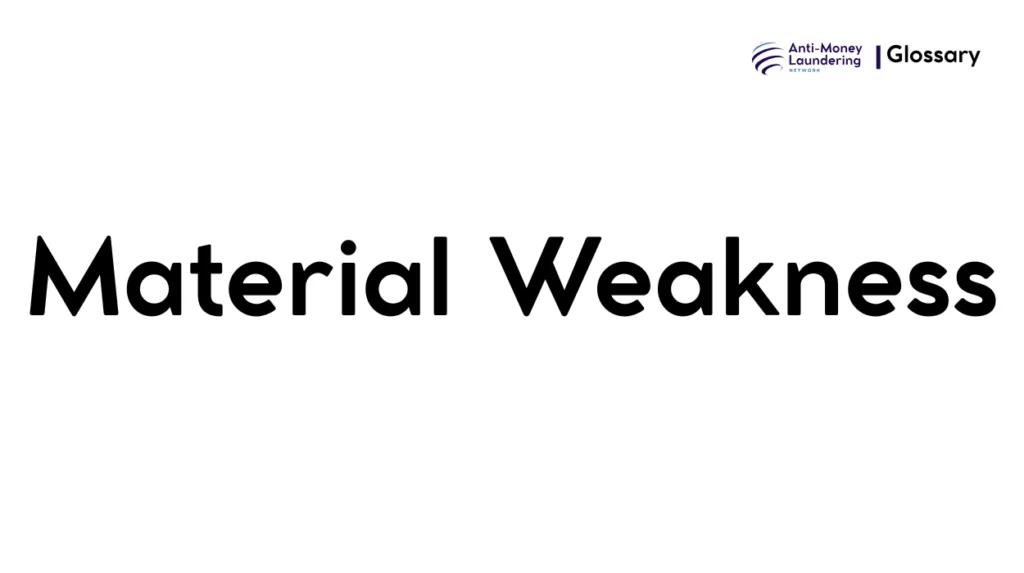Material weakness in Anti-Money Laundering (AML) refers to significant deficiencies or lapses in a financial institution’s AML controls, procedures, or governance that substantially impair its ability to prevent, detect, or report money laundering and terrorist financing risks effectively. These weaknesses create a vulnerability that can lead to regulatory breaches, financial crime exposure, and damage to the institution’s integrity and stakeholders’ trust.
Purpose and Regulatory Basis
Material weaknesses are critical in AML because they indicate that the existing control environment is insufficient to meet mandatory AML/CFT obligations, thereby increasing the risk that illicit funds may enter or move through the financial system undetected. Various global and national regulations emphasize identifying and rectifying such weaknesses to uphold the financial system’s integrity:
- FATF Recommendations: The Financial Action Task Force requires financial institutions and regulators to implement effective AML controls, with ongoing risk assessment to identify control deficiencies.
- USA PATRIOT Act: Mandates institutions to maintain robust AML programs, including internal controls that prevent money laundering, with reporting of significant control failures.
- EU AML Directives (AMLD): Require Member States to ensure financial institutions detect and remedy serious AML/CFT control deficiencies, reporting material weaknesses to supervisory authorities.
When and How it Applies
Material weaknesses surface during AML audits, regulatory examinations, or internal reviews. Examples include:
- Failures to adequately screen customer identity (KYC) or update risk profiles.
- Ineffective monitoring systems that miss suspicious transactions.
- Inadequate governance oversight or insufficient AML staff training.
When such weaknesses are detected, institutions must promptly inform regulators and implement remediation plans.
Types or Variants
Material weaknesses can manifest as:
- Policy/Procedure Weaknesses: Incomplete or outdated AML policies that do not align with current risks or regulations.
- Implementation Deficiencies: Failure to apply controls effectively, e.g., gaps in transaction monitoring or alert investigation.
- Governance Shortcomings: Lack of senior management oversight or inadequate resource allocation.
- Technological Gaps: Systems incapable of managing AML risks or generating accurate reports.
Procedures and Implementation
To comply with AML obligations, institutions should follow these steps:
- Risk Assessment: Identify areas where controls may be deficient.
- Control Evaluation: Review policies, transaction monitoring, KYC, and training programs.
- Reporting: Notify AML supervisors of identified material weaknesses as per regulatory timelines.
- Remediation: Develop and implement corrective action plans, including strengthening technology and enhancing governance.
- Continuous Monitoring: Regularly update risk assessments and controls to prevent recurrence.
Impact on Customers/Clients
From a customer perspective, detection of a material weakness may lead to increased due diligence, delays in transactions, or temporary restrictions to mitigate risks. Institutions may require additional documentation or impose enhanced monitoring to ensure compliance and risk mitigation.
Duration, Review, and Resolution
Material weaknesses remain active until fully remedied. Institutions must periodically review implemented measures for effectiveness and report progress to regulators. Some jurisdictions require formal closure confirmation from supervisory authorities.
Reporting and Compliance Duties
Financial institutions have a responsibility to document material weaknesses accurately, report them promptly to relevant AML/CFT authorities, and maintain transparent communication with stakeholders. Failure to do so may lead to regulatory sanctions, fines, or reputational damage.
Related AML Terms
Material weaknesses are closely linked with other AML concepts such as:
- Suspicious Activity Reporting (SAR)
- Know Your Customer (KYC) Deficiencies
- Control Deficiencies
- AML Risk Assessments
Challenges and Best Practices
Common challenges include underestimating the severity of weaknesses, inadequate training, and technological limitations. Best practices involve:
- Establishing a strong AML governance framework.
- Investing in advanced monitoring technology.
- Maintaining proactive communication with regulators.
- Regular training and awareness programs.
Recent Developments
Regulatory bodies increasingly emphasize centralized AML databases, such as the European Banking Authority’s EuReCA, to report and analyze material weaknesses across institutions. Advances in AI and data analytics also support early detection of control deficiencies.
Material weaknesses in AML represent critical failures in controls that jeopardize the detection and prevention of money laundering and terrorist financing. Recognizing, reporting, and remediating these weaknesses are vital responsibilities for financial institutions to ensure compliance, protect the financial system’s integrity, and maintain stakeholder trust.

